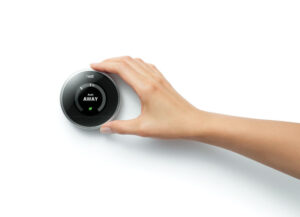By B. Denise Hawkins

Stop. Look around your room. More than likely there is a programmable thermostat on the wall, a plug strip on the floor and a light bulb in your lamp. These are three of the most common products you can use to help reduce daily household energy costs. The trick is figuring out how to make them work for you.
With a little savvy consumer shopping and research, choosing and correctly using programmable thermostats, replacement bulbs and plug strips can be easy to do.

Programmable thermostats
Shopping for a programmable thermostat? There are plenty of brands and types to suit your home and lifestyle. But one thing you won’t find today is a programmable thermostat that carries the Environmental Protection Agency’s (EPA) familiar blue Energy Star seal. The EPA dropped the label from these products in 2009. Why?
Programmable thermostats can potentially save buyers up to $180 a year on heating and cooling costs, according to ENERGYSTAR.gov, but many customers miss out on savings by failing to correctly install and use their new thermostats.
“Most people failed to use the programmable capabilities. They didn’t know how or didn’t want to,” says Brian Sloboda, a program manager specializing in energy efficiency for the Cooperative Research Network (CRN), the research and development arm of the National Rural Electric Cooperative Association.
This led to poor EPA consumer surveys, and ratings drops and the loss of the Energy Star seal for most products.
Enter smart thermostats, which are intended to be an easier-to-use alternative. They come with motion sensors that help do the work of detecting and setting the temperature in your home. Nest is one example of a smart thermostat.
“Sensors will start to turn the thermostat up or down, depending on the season,” Sloboda says. Within a few days of installing the device, he says the system will begin to learn your schedule, automatically dialing your thermostat back when you’re not home.
The addition of phone and iPad apps, are other smart thermostat features helping to make temperature control easy, Sloboda adds. “Using an app interface should be more intuitive than the old-fashioned programmable thermostat.”
Residential interior lighting
By now you know that Thomas Edison’s incandescent light bulb has evolved. January 2014 began the phase out and replacement with more energy efficient options. Currently, there are only three consumer choices — halogen-incandescents, CFLs and LEDs. With new light bulb standards in place in the U.S., the Department of Energy estimates consumers will save between $6 billion and $10 billion a year in lighting costs. But to get the energy savings and lower electric bills you want, you’ll have to pay more up front.
Sloboda warns as a new generation of lighting technology evolves, the brand you choose will matter.
“There is a whole lot of junk out there. You can buy name-brand LEDs for around $10 and more expensive ones from not-so-reputable companies,” he adds. But don’t take chances on your lighting or waste your money. Lighting experts recommend sticking with brands you know and trust.
GE and Sylvania have been longtime consumer lighting choices, but Sloboda says don’t overlook the lesser-known Cree lighting products. Cree has been a leader in the development of LED lighting. A 60-watt (800 lumens) Cree replacement bulb can cost about $10 at a big box store and is guaranteed to last at least a decade or more. Just spend some time reading the “lighting facts” on the back of the bulb box, Sloboda urges. It will come in handy when you want to narrow your lighting choice by temperature and color, which has nothing to do with the wattage. It means whether you want your bulbs to have a warm or cool tone when lit or have the look of “daylight” or “soft white.”
If you’ve been light shopping lately, you’ve probably noticed that smart devices have even come to the light bulb aisle. Manufactures like LG, more known for their appliances, and light bulb giant Philips are among those turning out LEDs that can be controlled by your cell phone and change colors to suit your mood.
“Today’s lighting is really starting to become part of a home’s entertainment system,” Sloboda said. With smart lighting, many come with software packages, he added. “You can do things like create a party mode, a romantic mode, a reading mode or a mode for watching TV.”
Power strips
They are usually trapped behind a desk or your TV, but traditional power strips work hard to affordably expand the number of electrical outlets in your home. Unfortunately, their convenience can encourage you to leave electronics plugged in all the time — and many devices keep drawing power even when you’re not using them. This so-called phantom or vampire power drain can waste electricity and be costly.
Smart power strips can help. They’re bigger, color-coded and designed to reduce usage by shutting down power to products that go into standby mode.
Most feature three outlet colors, each with a unique task. The blue outlet serves as a control plug, and is ideal for a heavily used device like a TV or computer. Anything plugged into red outlets stays on making them perfect for satellite boxes or other appliances that need constant power.
The remaining outlets, generally neutral or green in color, are sensitive to current flowing through the blue outlet, so turning off the TV or computer cuts power to them as well. With added occupancy sensors and timers, some smart power strips can be even more efficient. Costing about $20, these products can determine when to cut power to various devices. Sloboda says you can start to see a payback on your investment in about a year.
B. Denise Hawkins writes on energy efficiency issues for the National Rural Electric Cooperative Association, the Arlington, Va.-based service arm of the nation’s 900-plus consumer-owned, not-for-profit electric cooperatives.








